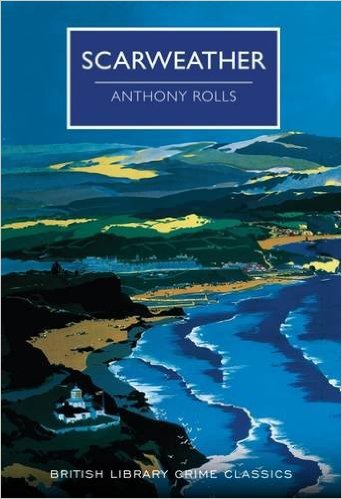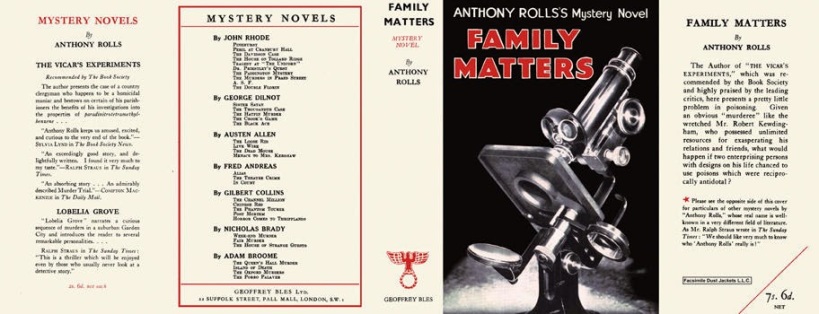Source: British Library Crime Classics (Review Copy)
Vintage Scavenger Hunt Item: Blue Object

Rolls was the penname of C. E. Vulliamy, (the unusual surname arising due to him having an ancestor who was a Swiss clockmaker) and he certainly put his career in archaeology to good use in his crime fiction writing. Rolls published his crime fiction in two periods. The first of these periods was in the 1930s, producing four crime fiction novels between 1932 and 1934, with Scarweather (1934) being the last from this period and in his introduction to the British Library crime classics edition of this story, Martin Edwards suggests that Frances Iles was an influence. Rolls’ second period of writing crime fiction was between 1952 and 1963, where he wrote a further six novels, though published under his real name. Out of these 10 books it is said that The Vicar’s Experiments (1932) is his most well-known and it is hard to avoid comparing it to Malice Aforethought (1931), as the experiments in question are the vicar’s attempts in murder.
The story takes place over 15 years and is written in retrospect by John Farringdale. He has two main friends at university; his cousin Eric Tallard Foster and Frederick Ellingham, who is a genius in the field of chemistry, is a ‘gifted musician,’ ‘not incapable of being sardonic’ and Farringdale says of him that he has ‘never known any man with a wider range of interests and of real attainment. He had a faculty for acquiring rapidly, not the rudiments alone, but the most reliable and intimate knowledge of any science or study.’ No prizes for guessing what role he is going to have in this story…
Foster although studying medicine is also interested in archaeology and strikes up a friendship with Professor Tolgen Reisby, who lives at Scarweather, an isolated coastal area. Foster also quickly develops a friendship with Reisby’s much younger wife, Hilda, and the reader is not surprised when Farringdale becomes concerned at how close they are becoming. Tragedy strikes in July 1914 when Foster disappears during a visit to Reisby. The police are satisfied it is an accident, that Foster drowned when going for a swim in the middle of the night. Ellingham though is far from sanguine about this theory, especially considering the various suspicious things he knows about Reisby. Yet little can be done as WW1 begins and both Ellingham and Farringdale are called up. However, this does not mean Ellingham has forgotten his suspicions about Foster’s disappearance and over the years further hints as to what he is thinking are given and we also see how other characters in the drama change over time, not always for the better. Further disappearances also add to the mystery.
Overall Thoughts
Rolls adopts a more unusual structure in his mystery novel. The book also focuses more on the consequences of committing a crime than the uncovering of one. These are bold choices, which may not appeal to everyone, though it was refreshing to see a less than conventional narrative structure employed. Yet what lets it down is the length of the novel in proportion to the story content. It did need shortening, especially given the ease by which the reader can solve the mystery early on. The longitudinal aspect of the novel did give the case a realistic quality, the way an event can seem suspicious or mysterious at the time but is not acted on due to insufficient evidence, yet still lingers on in people’s minds over time. However, this realism did not affect the pacing of the story so a shorter time frame may have been better.
Unsurprisingly Rolls recreates the archaeological milieu well and it does have an interesting role in the central mystery, though it would have been better if its role had been a little more hidden in the story. He also seems to have a lot of fun portraying his archaeological characters humorously. Ellingham is a sleuth in the Holmes mould, though he lacks the witty deductions of the Baker Street detective. Ellingham is rather taciturn in his investigative work, though interestingly his actions do raise some ethical questions, with then being rather high handed at times, especially at the denouement of the novel. Farringdale makes a good narrator on the whole, though ironically for a barrister he doesn’t really show much of a legal mind. He is perhaps a little too conscious of his narrating role, but not to an annoying extent. It did amuse me when he writes the fairly snobbish line that ‘it has always been my belief, that only intelligent people know how to enjoy themselves.’ An unexpected but pleasing aspect of the book’s characterisation was in the social milieu of Scarweather, as it was somewhat reminiscent of the casts of characters Jane Austen created, especially with the local magistrate Macwardle and his two middle aged unmarried daughters. I would have liked this aspect of the book to have been gone into in more detail than it was.
Although this was rather a slow burner of a novel I have not written Rolls off, as the British Library are reprinting another of his works in March, from his first crime writing period, Family Matters (1933) and I have read good things about it, suggesting that it is a stronger work.
Rating: 3.5/5
N. B. I didn’t include the original cover for Scarweather due to the spoilers it gives away. This is something that Martin Edwards said Dorothy L Sayers remarked upon when she reviewed it.
Click here for Curtis Evans’ (The Passing Tramp blog) and Martin Edwards’ (Do you write under your own name? blog) thoughts on the book.


I have this one yet to read. It sounds as though you liked it but didn’t love it. Am I right in that?
LikeLiked by 1 person
Yeah its definitely an in the middle sort of book. Lots of good points with the characters, setting, archaeological milieu. But pace and mystery complexity needed to be improved.
LikeLike
I’ll try it and let you know what I think.
LikeLike
Oh dear, it’s slightly depressing to hear books needing to be shortened when they weren’t overly long in the first place. I shall wait and invest my money in ‘Family Matters’ instead! Thanks for the review. 🙂
LikeLiked by 1 person
FAMILY MATTERS is the best of Rolls’ crime novels I’ve read. Simply brilliant! I summed it up this way when I reviewed three years go: “Here is an engrossing and penetrating novel that expertly combines elements of the inverted crime novel, the detective novel and the novel of psychological suspense into one rewarding package.”
LikeLiked by 1 person
Certainly seems like I’ll have to pick up a copy of FM next month. Glad it is such an excellent read.
LikeLike
[…] on from this book I read Anthony Rolls’ Scarweather (1934), another book published in the 1930s. Although Rolls is a good writer the simplicity of the […]
LikeLike
[…] or disliked the same books as me. At times our opinions converged such as with Anthony Rolls’ Scarweather, which she too found to have a quite simple plot. We both also enjoyed Murder Underground by Mavis […]
LikeLike
[…] go. The plot of Family Matters showcases Rolls’ talents as a writer much more effectively than Scarweather (1934). The majority of the action of this book takes place in the bizarrely yet wonderfully named […]
LikeLike
[…] Kate from Crossexaminingcrime also reviewed the novel. […]
LikeLike
[…] Next up is Ulrich Suerbaum’s chapter on the ‘Rules of the Game: Agatha Christie’s Construction of the Detective Story’, which recycles well-worn criticisms of Christie e.g. her characters having no psychological depth etc. and has a clichéd understanding of her novels and their structure. Archaeology doesn’t really come into it, so not really sure how this chapter made it into the collection. The subsequent chapter though is much better, with Volker Neuhaus’‘The Archaeology of Murder.’ Stronger background knowledge of golden age detective fiction is present, with references to Ellery Queen and Ernest Bloch’s essay on ‘The Form of the Detective Story and Philosophy’ is explored a lot at the start of the chapter. Archaeology as a metaphor for detecting is a key idea which comes through in this piece by Neuhaus and his citing of mystery fiction which merge these two themes is good, mentioning some novels I had not heard of before, such as John Trench’s Docken Dead (1953) and Dishonoured Bones (1954). Though it did surprise me that he did not mention Anthony Rolls’ Scarweather (1934). […]
LikeLike
[…] Rolls – Scarweather (1934). (If you want to give him a go I would recommend Family Matters (1933) […]
LikeLike
[…] Object: Scarweather by […]
LikeLike
[…] Crime Classics series will also see some similarities between this story and Anthony Rolls’ Scarweather. However this does not mean the solution follows this pattern, as Bell goes off in her own […]
LikeLike
[…] stereotyping there then… After that we jump to 1934 with the publication of Anthony Rolls’ Scarweather, mainly set on part of the Yorkshire coast, followed by John Rowland’s Murder in the Museum […]
LikeLike
[…] mysteries I have read are: ‘The Adventure of the Egyptian Tomb’ (1923) by Agatha Christie, Scarweather (1934) by Anthony Rolls, Murder in Mesopotamia (1936) by Christie, Blood from a Stone (1945) by […]
LikeLike
[…] They were both reprints from the British Library Crime Classics series: Family Matters (1933) and Scarweather (1934). Today’s read, with its striking cover, comes from the author’s second writing period […]
LikeLike